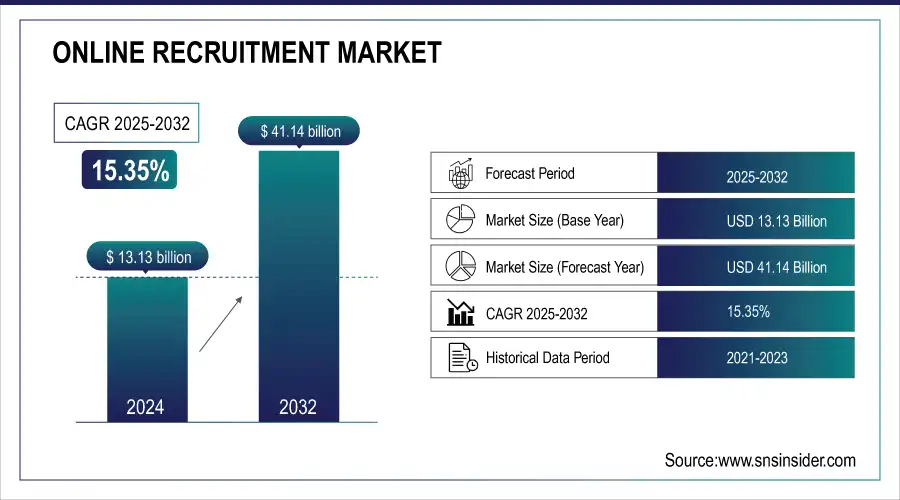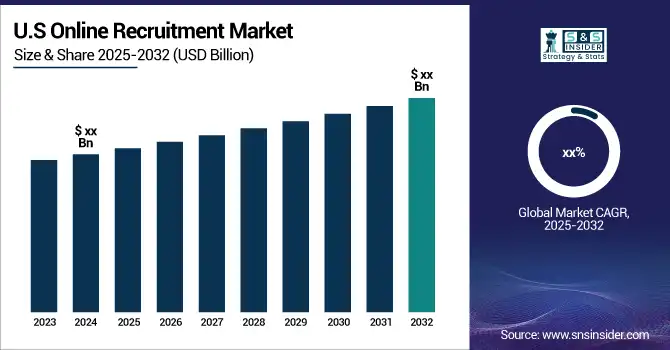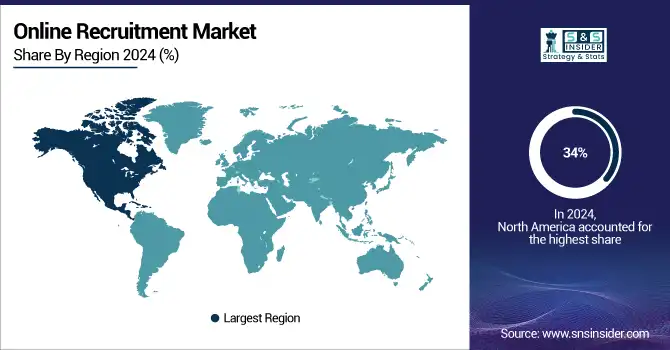Online Recruitment Market Report Scope & Overview:
The Online Recruitment Market size was valued at USD 13.13 billion in 2024 and is expected to reach USD 41.14 billion by 2032 and grow at a CAGR of 15.35% over the forecast period of 2025-2032.

Get more information on Online Recruitment Market - Request Sample Report
The increased number of job openings allows for online recruitment platforms to streamline processes like resume management solutions and employee screening tools. This demand is driven by a move to outsource manual recruiting processes to online platforms. Furthermore, the demand for smartphones is increasing which in turn has led to an upsurge in mobile-based recruitment solutions and this supports market growth. According to a recent study, the time to hire in the US is 39 days on average (it can go from more than a month depending on industry and job role). In the case of tech jobs, this can even go up to 43 days. That means US companies must pay on average $4,701 per hire. This encompasses everything from job postings, and recruiting software to the salaries of recruiters.

Market Size and Forecast:
-
Market Size in 2024: USD 13.13 Billion
-
Market Size by 2032: USD 41.14 Billion
-
CAGR (2025–2032): 15.35%
-
Base Year: 2024
-
Forecast Period: 2025–2032
-
Historical Data: 2021–2023
Key Online Recruitment Market Trends
-
Increasing adoption of AI & Machine Learning in recruitment platforms for candidate screening, resume parsing, and interview scheduling.
-
Rapid growth of mobile-based recruitment solutions due to smartphone penetration and rising mobile job applications.
-
Expansion of cloud-based recruitment software, enabling scalability, remote accessibility, and integration with HR systems.
-
Integration of social media platforms such as LinkedIn, Facebook, and Instagram for targeted job advertising.
-
Growing demand for video interviewing & chatbot solutions to streamline remote hiring processes.
-
Rising focus on data-driven recruitment & analytics, supporting better decision-making and diversity hiring.
-
Digital transformation across industries driving outsourcing of traditional recruitment processes to online platforms.
Online Recruitment Market Growth Drivers
-
Online recruitment enhances efficiency and reduces costs by streamlining candidate search, application processing, and communication.
-
It leverages AI and machine learning to improve candidate matching, minimize biases, and ensure better hiring quality.
-
The widespread availability of high-speed internet allows companies to access a diverse and global talent pool.
The global online recruitment market has been supported by the increasing penetration of the internet which allows employers and job seekers to access digital platforms that offer jobs. According to the International Telecommunication Union, only 65% of people around the world have access to the internet as per its data until the year 2024. This wider access to the internet has changed how we job-hunt, making it possible for candidates from anywhere in the world to compete on a level playing field with employers all over. Just take the United States where the Pew Research Center claims internet penetration is already at almost 92%. This was a very high rate of connection, which meant that people could now connect (over the phone) to a given list of applications running on some important online recruitment platforms like LinkedIn, Indeed, and Glassdoor. Online recruitment is worldwide, with LinkedIn itself having over 900 million users globally.
The increased accessibility allows companies to access a wider talent pool, something that can be especially helpful for businesses seeking specialized skills they may not find locally. In 2024 the U.S., nearly all employers use (76%) of online job boards because it is hard to overlook how important Internet access has been in shaping recent recruitment trends. This growth in online hire is also being facilitated by increasing mobile access, with over half of all web traffic now coming from a mobile. This transition brings a possibility for desiring job seekers to expect locations of their choice and apply, further leading recruiters towards the direction that adds flexibility and efficiency in finding candidates from both employers and candidates.
Online Recruitment Market Restraints
-
The ease of access to online platforms increases competition among companies for top talent, making it challenging to attract the best candidates.
-
Handling and protecting candidate data online raises concerns about privacy and security, which can affect user trust.
-
The high volume of applications from online platforms can be overwhelming, requiring efficient management and screening processes.
The Issues Related to data privacy act as major limitation in the market. the increasing volume of personal and sensitive data being shared on recruitment platforms, ensuring data protection is important. As per a survey by the International Association for Privacy Professionals (IAPP), 78 % of the companies have increased data breach and risk management concerns, and compliance with laws like GDPR (General Data Protection Regulation) & CCPA (Personal Privacy Act). This makes these concerns even more prevalent in recruitment, where candidate information such as resumes and contact details are especially sensitive. This includes additional costs associated with acquiring appropriate cybersecurity measures and more responsibilities in navigating the regulatory landscape for data protection, complicating company management of online recruitment processes.
Online Recruitment Market Segmentation Analysis
By Type, Permanent Online Recruitment Leads Market While Part-Time Online Recruitment Set for Fastest Growth
Permanent Online Recruitment held the largest revenue share of the market over 80% in 2023. Driven through several factors that comprehensively address the current requirements in a digital economy. Digital platforms have made the recruitment process more efficient and accessible, meeting the growing demand for permanent employees as organizations seek long-term stability and strategic alignment in their workforce. Online recruitment tools are getting smarter with their sophisticated filtering and matching process which ultimately improves the quality of hires while reduced hiring costs. Data analytics and advanced filtering algorithms ensure that companies utilizing these platforms to make permanent hires have access to a more extensive pool of talent and are well-placed to create better matches for their respective roles. All of these are designed to help employers determine if the candidate has enough experience and skills, but also align well with company culture/ values. Additionally, the security offered by permanent positions is highly valued by employees, attracting more qualified candidates in today’s job market.
The Part-time online recruitment segment, while smaller, serves a different market need. It meets the increased need for flexibility, especially among the young generation, freelancers, and those seeking work-life balance. This segment leverages same technological advancements but caters to industries/roles where flexible staffing is more prevalent such as retail, hospitality, emerging gig economy. The Part-time Online Recruitment segment, with a smaller market share in terms of revenue, is anticipated to become the fastest growing increasingly adopting flexible employment practices in response to changing work preferences and economic conditions.

By Technology, Video Interview Platforms Lead Market While Chatbots Poised for Fastest Growth
The process of recruitment is getting digital from a traditional few years back. Corporations are witnessing massive growth, hiring a thousand candidates each day, and to organize this number of candidates have started using video interview technology with AI support. It simplifies the process of recruiting without the need to visit places that are not necessary, therefore saving time for job seekers and a great relief for companies.
The Chatbot segment is projected to grow with the significant annual growth rate during the forecast period, a result of growing AI based technology adoption by business. They improve a candidate's journey, make responding faster, and give advice on application. They also aid in people analytics providing insights into candidate behaviour and preferences. These technologies are changing the game on recruiting, and it is much faster to streamline all of those as part of technology progression.
By Application, IT Sector Dominates Online Recruitment Market While Other Industries Rapidly Expanding
The IT sector was the largest segment in online recruitment industry, which contributed over 25% of market share revenue on 2023. These initiatives have surged the demand for IT professionals in various industries, consequently resulted into a growing leadership footprint. Companies are using advanced technologies like artificial intelligence, machine learning, and cloud computing combined with their processes, and the need for qualified IT staff to manage or implement said solutions has risen sharply. IT sector has become one of the most significant industries in the online recruitment industry. The global movement to work from anywhere practise and increasing focus on cybersecurity as firms technologically transform corporate laboratory environments in addition has built upon this dominance. The IT sector, in which many positions need special technical knowledge or skills especially benefits from online recruitment solutions. The roles are matched with job requirements through these platforms using advanced algorithms and data analytics.
Utilizing a global talent pool has resulted in significant gains for employers to onboard complex, high specialized IT workforces. Something that is becoming more and more important, even key to your future competitiveness or making sure you can still operate in the modern world of technology. Organizations are continuing to hunt for talented IT professionals and this segment probably offers the unmatched level of dominance in as an offer, which should prevail at some extent with every online recruitment platform that does such services.
Online Recruitment Market Regional Analysis:
North America Online Recruitment Market Insights
North America held the largest share of more than 34% in the online recruitment market in 2023. This is further driven by a well-digitized corporate sector and the wide adoption of advanced technology companies. Both the U.S. and Canada are early adopters of new technology, such as sophisticated recruitment software featuring AI (artificial intelligence) and ML (machine learning), to help simplify recruiting tasks. In the most recent data, online recruiting platforms are used to some extent by around 80%-90% of U.S. companies. These innovations help an organisation in bridging the gap between their potential candidates and job openings, making recruitment a more responsive process while saving time & cost positioning North America as a key market for online recruitment solutions. North America benefits from a highly skilled workforce and a culture that embraces job mobility and career changes, driving the demand for online recruitment services. The region's strong economic environment and the presence of numerous global corporations necessitate a dynamic recruitment market that can adapt to rapidly changing employment needs and job specifications. Through recruitment marketing technology and AI, key employers in North America can automate repetitive activities like responding to the queries of job seekers; scheduling interviews with candidates for multiple roles or positions as well conducting initial screenings.

Need any customization research on Online Recruitment Market - Enquiry Now
Asia-Pacific Online Recruitment Market Insights
The APAC region, driven by factors that are unique and distinguishable in shaping your recruitment strategy for success. The online recruitment market in Asia Pacific is witnessing growth due to the increasing preference for automating talent acquisition and leading HR management solution providers extending their reach across emerging economies amidst the technological advancements shaping up an innovative business environment. There is a high global adoption of online recruiting as well, with many developed countries huge number of companies using the online platform. In Europe, this figure is on the order of 70% to 80%, for example. LinkedIn, Indeed, Glassdoor, and Monster are the top major job boards that are widely used. LinkedIn has more than 900 million members, and many companies have used this platform for recruitment. Mobile recruiting is becoming a big deal, and companies are beginning to optimize their career sites (and application processes) for smartphones, approximately 60% of those seeking jobs use their smartphones to search.
Europe Online Recruitment Market Insights
Europe accounted for around 28% market share in 2024, driven by widespread adoption of online recruitment in the U.K., Germany, and France. Stringent labor regulations and a focus on transparent hiring practices have encouraged employers to adopt structured online solutions. Germany, with its strong industrial and technology workforce demand, represents one of the largest markets, while the U.K. emphasizes flexible workforces and mobile recruiting adoption. Companies like Adecco, Randstad, and Hays maintain strong positions in the region.
Latin America (LATAM) and Middle East & Africa (MEA) Online Recruitment Market Insights
Latin America (LATAM) accounted for nearly 7% of the market in 2024, led by Brazil and Mexico. The region is witnessing growing adoption of online recruitment due to expanding internet access, increasing mobile penetration, and corporate digital transformation. Government initiatives to support digital job creation also boost platform adoption.
The Middle East & Africa (MEA) held around 5% market share in 2024. The market is growing steadily due to investments in digital HR solutions in the UAE, Saudi Arabia, and South Africa. The rise of smart cities, economic diversification programs, and demand for international workforce mobility are key contributors. However, lower internet penetration compared to other regions poses a challenge to growth.
Online Recruitment Market Key Players:
- LinkedIn Corporation (Microsoft)
- Indeed (Recruit Holdings Co., Ltd.)
- Glassdoor
- Monster Worldwide, Inc.
- ZipRecruiter
- CareerBuilder, LLC
- Hays plc
- Randstad Holding N.V.
- Adecco Group
- Robert Half International Inc.
- Korn Ferry International
- Allegis Group
- Upwork Inc.
- Fiverr International Ltd.
- Jobvite, Inc.
- Workday, Inc.
- BambooHR
- iCIMS, Inc.
- SmartRecruiters
- SimplyHired
Online Recruitment Market Competitive Landscape
LinkedIn is the world’s largest professional networking platform with over 900 million users globally. It provides advanced online recruitment tools, including LinkedIn Recruiter and Talent Hub, offering data-driven insights into candidate availability, skills, and market trends.
- In 2023, LinkedIn launched Talent Hub, a platform offering real-time insights into talent pools and labor market dynamics, improving recruiters’ ability to make informed hiring decisions.
Indeed is a global leader in job search and recruitment services, providing employers with direct job postings and candidate database access. The platform dominates in the U.S. and continues to expand internationally.
- In 2023, Indeed introduced enhanced AI-powered job matching features, improving alignment between job descriptions and candidate resumes to increase recruiter efficiency.
Glassdoor specializes in employer branding and recruitment, enabling companies to showcase culture, benefits, and employee reviews while connecting job seekers with openings.
- In 2023, Glassdoor expanded its integration with Indeed, providing joint employer branding solutions and streamlining job advertising across both platforms.
| Report Attributes | Details |
| Market Size in 2024 | USD 13.13 Billion |
| Market Size by 2032 | USD 41.14 Billion |
| CAGR | CAGR of 15.35% From 2025 to 2032 |
| Base Year | 2024 |
| Forecast Period | 2025-2032 |
| Historical Data | 2021-2023 |
| Report Scope & Coverage | Market Size, Segments Analysis, Competitive Landscape, Regional Analysis, DROC & SWOT Analysis, Forecast Outlook |
| Key Segments |
• By Type (Permanent Online Recruitment, Part-Time Online Recruitment) • By Job Type (Secretarial or Clerical, Accounting and Financial, Computing, Technical, and Engineering, Professional or Managerial, Medical, Hotel or Catering, Sales or Marketing, Other Industrial or Blue Collar) |
| Regional Analysis/Coverage | North America (USA, Canada, Mexico), Europe (Germany, UK, France, Italy, Spain, Netherlands, Rest of Europe), Asia-Pacific (Japan, South Korea, China, India, Australia, Rest of Asia-Pacific), The Middle East & Africa (Israel, UAE, South Africa, Rest of Middle East & Africa), Latin America (Brazil, Argentina, Rest of Latin America) |
| Company Profiles | LinkedIn Corporation (Microsoft), Indeed (Recruit Holdings Co., Ltd.), Glassdoor, Monster Worldwide, Inc., ZipRecruiter, CareerBuilder, LLC, Hays plc, Randstad Holding N.V., Adecco Group, Robert Half International Inc., Korn Ferry International, Allegis Group, Upwork Inc., Fiverr International Ltd., Jobvite, Inc., Workday, Inc., BambooHR, iCIMS, Inc., SmartRecruiters, SimplyHired |

